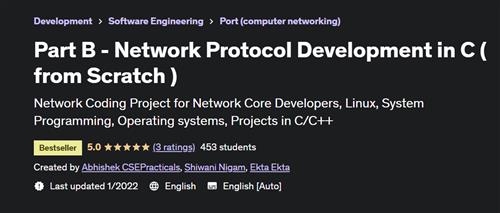Part B - Network Protocol Development in C ( from Scratch )

Last updated 1/2022
Created by Abhishek CSEPracticals,Shiwani Nigam,Ekta Ekta
MP4 | Video: h264, 1280x720 | Audio: AAC, 44.1 KHz, 2 Ch
Genre: eLearning | Language: English + srt | Duration: 59 Lectures ( 8h 12m ) | Size: 3.52 GB
Network Coding Project for Network Core Developers, Linux, System Programming, Operating systems, Projects in C/C++
What you'll learn
Understand how Network Protocols are implemented on Network Devices
Packet processing, Update protocol data structures through packets processing
Debugging and troubleshoot code to resolve issues
Implement new features incrementally
Implement complex protocol state machines and Network Algorithms
The AIM of this project is to cycle you through the experience of end-to-end implementation of a typical network protocol
Requirements
Must have Completed Part A of the Course
Description
First of all Congratulations on completing the Part-A of this Course in which we develop the Adjacency Mgmt feature of the protocol. I hope you enjoyed and had a great learning. You must be Feeling confident in developing timer-based state machines now?And here starts a new challenge when we enter into Phase 2 of the Project - Link State Database Mgmt. Every Router will use its Adjacency Objects sitting on an interface to build its local Link State Database. But the challenge is - every router has to share its own local copy of the link-state database ( LSDB ) with every other router in the topology running ISIS protocol so that every router has a coherent and common view of the IGP topology. This is what is the end goal of this phase of the project.This full course series is divided into 3 parts - Part A, Part B, and Part C out of which Part A and B are Live, and Part C is under Development as of 21 Dec 2021.Once again we shall cover all required theories and concepts before we hit the keyboard for implementation. The three main concepts we shall going to implement in this installment of the course are :1. Concept of Packet Flooding2. Building of Link State Database3. Link State Database SynchronizationWe shall continue to use Timers as phase 2 is also heavily dependent on timers to achieve its goals. In addition to timers, we shall also get to introduce to the world of Asynchronous programming through this project.Continue to Challenge yourself by doing more of such projects and you will not even realize that you have already transformed yourself into a 10x Developer.Project GoalsThe AIM of this project is to cycle you through the experience of end-to-end implementation of a typical network protocol. In this case study, we have chosen a routing protocol as an example, but the high-level logistics involved to implement a typical network protocol are more or less the same. For example, a typical network protocol has to:Configurable via CLIsShow internal states and results through show CLIsRespond to generic configuration changes ( such as link shut-down, IP Address on interface change, etc)Compute results and install the results in Tables (Routing Information Base, MAC Tables, hardware Tables, etc )Respond to Topological Changes (link failures, device failures, etc )Time-out stale Data structures if any.Periodically Generate Or Process Protocol packetHow to add a new feature to the existing working Protocol Codebase. (This is what you shall be doing all your life as a software engineer !!)Since the project is quite big (I am expecting around 10k LOCs), you would also get the opportunity to learn how to :Organize the code in header and src filesModularize the codebase: How to keep the code of different features in different src filesTesting the new feature, and cross-check it doesn't break existing featuresMaintain Code Commits through Version control system ( Github in this case )Bug Fixing, and exercising various debugging techniques (gdb, Valgrind, etc )Needless to say, you Can't exercise the above points unless you do a project of considerable size.
Who this course is for
Core Developers aiming to work in Networking / Distributed Systems / System Programming side
Not for those seeking non-development roles ( This is pure Dev oriented Course )
Not for those still struggling with basic data structures, basic C programming concepts
Working professionals, Job Seekers, domain changers to Networking Dev, Learners, starving for knowledge
Homepage
https://www.udemy.com/course/nw_proto_dev_partb/1DL
rmyws.Part.B..Network.Protocol.Development.in.C..from.Scratch..part1.rar
rmyws.Part.B..Network.Protocol.Development.in.C..from.Scratch..part2.rar
rmyws.Part.B..Network.Protocol.Development.in.C..from.Scratch..part3.rar
rmyws.Part.B..Network.Protocol.Development.in.C..from.Scratch..part4.rar
Rapidgator
DOWNLOAD FROM RAPIDGATOR.NET
DOWNLOAD FROM RAPIDGATOR.NET
DOWNLOAD FROM RAPIDGATOR.NET
DOWNLOAD FROM RAPIDGATOR.NET
Uploadgig
DOWNLOAD FROM UPLOADGIG.COM
DOWNLOAD FROM UPLOADGIG.COM
DOWNLOAD FROM UPLOADGIG.COM
DOWNLOAD FROM UPLOADGIG.COM
NitroFlare
DOWNLOAD FROM NITROFLARE.COM
DOWNLOAD FROM NITROFLARE.COM
DOWNLOAD FROM NITROFLARE.COM
DOWNLOAD FROM NITROFLARE.COM
Please Help Me Click Connect Icon Below Here and Share News to Social Network | Thanks you !
In today's era of digital learning, access to high-quality educational resources has become more accessible than ever, with a plethora of platforms offering free download video courses in various disciplines. One of the most sought-after categories among learners is the skillshar free video editing course, which provides aspiring creators with the tools and techniques needed to master the art of video production. These courses cover everything from basic editing principles to advanced techniques, empowering individuals to unleash their creativity and produce professional-quality content.


Comments (0)
Users of Guests are not allowed to comment this publication.